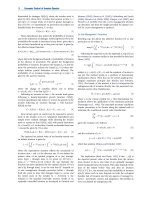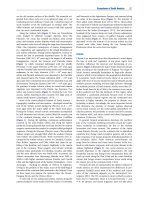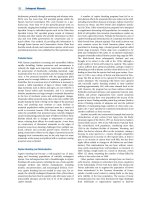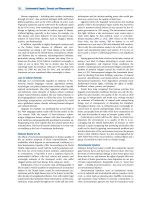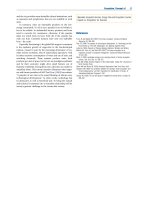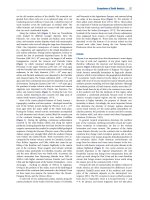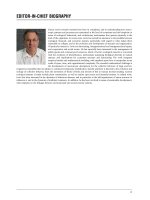Encyclopedia of biodiversity encyclopedia of biodiversity, (7 volume set) ( PDFDrive ) 1596
Bạn đang xem bản rút gọn của tài liệu. Xem và tải ngay bản đầy đủ của tài liệu tại đây (36.97 KB, 1 trang )
Ecology of Agriculture
monocultures in which pesticides are used. Recent pest
management programs in Southeast Asian paddy rice have
taken deliberate advantage of this diversity and drastically
reduced pesticide inputs without sacrificing yields. In traditionally managed rice fields, the predators are likely to
include fish and amphibians, which contribute to pest regulation and also provide additional nutritional resources for
farm families.
Unplanned Diversity and Soil Processes
Despite some significant advances in our understanding
of soil processes, we know relatively little about the soil
biota and their impact on agricultural productivity. In natural
ecosystems, decomposition and soil nutrient cycling are
regulated by a diverse community of invertebrates and
microorganisms, such as termites, earthworms, nematodes,
fungi, and bacteria. The composition, abundance, and activity
levels of the soil biota in agricultural systems are markedly
different from those in surrounding natural ecosystems. For
example, the diversity and abundance of soil insects and
earthworms in tropical agroecosystems are typically significantly reduced compared to those of a wide range of undisturbed tropical ecosystems. In cases in which abundance
remains high in agricultural systems, the soil communities are
often dominated by a single or small number of species highly
adapted to the modified environment.
The changes in the soil community under agriculture result
from a variety of perturbations to the soil environment. The
initial conversion from undisturbed ecosystems typically involves the removal and/or burning of plant biomass followed
by tillage – activities which have drastic impacts on soil
structure and soil chemistry. The physical changes at the soil
surface amplify diurnal and seasonal fluctuations in temperature and moisture. In addition, organic inputs to the soil
are significantly reduced as a result of plant biomass removal,
and the chemical composition of organic inputs is altered.
These extreme modifications of the soil environment can result in the elimination of some soil organisms and, at a
minimum, are likely to change the competitive balance among
species. To the extent that agricultural systems minimize these
perturbations (e.g., by reducing tillage or burning), the impacts on the soil community may be less severe.
Despite these well-known effects of agricultural conversion
on the soil community, the link between loss of soil biodiversity and various ecological processes has not been extensively studied. Decomposition and nutrient mineralization,
for example, are controlled by the activities of a diverse
community of organisms. It is not clear that the loss of some
species will result in significant changes to these functions,
but the degree of functional redundancy among different
species is still controversial. However, some processes such as
nitrogen fixation are carried out by very specific organisms,
whose loss might substantially affect nitrogen cycling. Given
the importance of soil biota for decomposition and nutrient
cycling, it is essential that the link between this component of
unplanned diversity and ecological processes be explored
more fully.
13
Agriculture and Diversity in the Landscape
Agroecosystems typically sit in a landscape of multiple land
uses. Human-modified landscapes fall along a continuum
from relatively homogeneous landscapes consisting of a small
number of cropping systems to heterogeneous mosaics of diverse cropping systems within a matrix of natural ecosystems.
Agricultural activities can have important effects on natural
ecosystems through the movement of organisms, pesticides,
nutrients, and soil. At the same time, the landscape context
can strongly influence ecological processes that occur within
agroecosystems, such as pollination and pest regulation. The
spatial structure of the landscape, including the size, shape,
and connectedness of different ecosystem types can have
dramatic effects on these ecological processes.
Consequences of Agricultural Activities
Ecological concepts have often been utilized to address the
consequences of agricultural perturbations for natural ecosystems in agricultural landscapes. Agricultural intensification
can diminish ecosystem services such as the provision of clean
water due to increased nutrients, agrochemicals, and dissolved
salts entering groundwater and surface water. Significant
sedimentation of waterways and dams results from the loss of
riparian vegetation that often accompanies intensification. The
impacts of nutrient inputs and pesticides for downstream
aquatic and terrestrial ecosystems have been well studied.
Much of the pesticide applied to crops fails to reach the target
pests and instead moves into adjacent ecosystems, where it can
have significant impacts on the diversity and abundance of
nontarget species. Studies have shown that pesticides have
strong effects on trophic dynamics and a range of ecosystem
processes in complex natural ecosystems, both aquatic and
terrestrial. Similarly, movement of nitrogen from agroecosystems to natural ecosystems through leaching or deposition
may lead to significant impacts at several trophic levels. Increased nitrogen loading may reduce plant species richness
while increasing the biomass of dominant species. In response
to these changes, both pathogens and herbivorous insects are
likely to exhibit lower species richness but higher population
abundance, just as they do in agricultural systems. Changes in
pathogen and herbivore populations may in turn influence the
productivity and fitness of their host plants. Even in the absence of changes in herbivore population pressure, research
has shown that the effects of herbivory on plant growth and
reproduction may be more severe at high levels of nutrient
availability. As with the complex effects of pesticides, these
impacts of inadvertent fertilization are likely to impact trophic
dynamics and ecosystem processes.
Spillover of Organisms from Agroecosystems
In addition to the movement of soil and agricultural inputs, a
variety of organisms move from agroecosystems to natural
ecosystems in agricultural landscapes. There is abundant evidence that pathogens move from domestic animals to wild
animals (and humans), along with more limited evidence for
movement of plant pathogens from crops to wild plants
